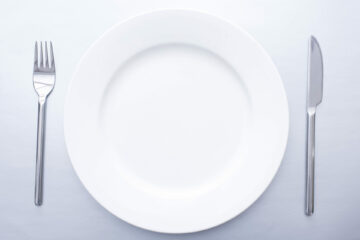When it comes to healthy eating, the importance of what you put in the cupboard can be easily often overlooked. Yet a few changes to its content can become an effective way of building a healthy eating routine, and good ideas for healthy eating on the go.
Carbohydrate sources
When choosing healthy carbohydrates, wholegrain and fibre-rich carbohydrates are some great go-to options.
Potatoes/sweet potatoes
These starchy vegetables go nicely with many meals. Where possible, clean them thoroughly and eat the skin as well, so that you can benefit from all the fibre they have to offer. A trick to keep potatoes as long as possible without them turning green is to keep them is a brown paper bag. This will allow plenty of ventilation and prevent light exposure.
Wholegrain pasta and jars of tomato pasta sauce
If you are a fan of pasta, you may find this combination helpful. Wholegrain pastas are richer in fibre and other micronutrients than the white alternatives, and they do not influence blood sugars as greatly. Combine with a jarred pasta sauce (try to go for one without any added sugars), then you can have a tasty and quick meal. Why not also try out a lentil pasta for more protein and longer satiety?
Whole grain breakfast cereals
If you feel hungry in the morning, a balanced breakfast is a great option. As more research has been carried out, we now know that the human body is able to regulate blood sugar better in the morning compared to later in the day. Having breakfast may also lower the chance of excessive eating later in the day. To make preparing breakfast as easy as it can be, you could consider one of the follow cereals to keep in your kitchen: shredded wheat, Weetabix, bran flakes, low- sugar muesli or oats. Be aware of cereals with added sugar, or those with a low fibre content (less than 6g fibre per 100g cereal). Try to see if the product label shows that the cereal is fortified with nutrients such as calcium and vitamin b-12, especially if you are vegetarian or vegan.
Protein sources
Tinned fish
If you find yourself in a hurry and don’t have time to cook proteins, an easy option is to keep tinned fish in your cupboard. These cooked fish comes in a variety of flavours,. The most optimal options are tinned fish in water or tomato sauce. If your goal is dietary enrichment, fish in olive oil would also be great. Some sauces contain too much salt, similar to fish stored in brine. In terms of the fish species, oily fish provides omega 3 fatty acids. This makes selections such as salmon, mackerel and sardine good choices.
Beans and lentils
These grains have a long shelf life and make both an excellent source of complex carbohydrates and protein. Lentil soups are simple to make, or you could enrich your salad with some cooked beans to give you that extra protein. The fibre in them means that not all the carbohydrate content will be digested. This can also keep you full for longer and help prevent peaks in blood sugar. For an easier option, choose tinned beans and lentils. These are usually ready-cooked but double check for any added salt or oils they may contain.
Nuts
Nuts are a good protein source and can be eaten as snacks as well as used in cooking. They are also high in polyunsaturated fats at the same time, contributing to better cholesterol control, as well as being a source of omeg 3 fatty acids. Be mindful of overall portion size due to overall fat levels – adding in a variety of nuts will help ensure you get a range of nutrients!
Fruits and vegetables
Dried fruits
Dried fruits such as apricots and raisins have a long
shelf lives, and 1 portion will count toward your five-a-day. They A few pieces of dried fruit can be served as a topping for your breakfast cereal. Dried plums may help with those suffering from constipation, however be aware that dried fruit is a concentrated source of sugar, so its important to keep in mind portion sizes overall.
Tinned fruits and vegetables
To many people’s surprise, canned fruits and vegetables can be just as nutritious as their fresh or
frozen counterparts. This is because canning stops the nutrient loss during the storage and allows advanced stages of ripening to happen before harvesting. These are usually not achievable in fresh fruits and vegetables due to the time-sensitive nature of their transportation and storage. In other words, if you allow fruits and vegetables to fully ripen before harvesting, they will likely spoil before arriving the supermarket shelves. But you can allow the fruits to reach their peak of nutritiousness on the plants when you know they go straight into a can and become perfectly preserved. Always double check the label to go for products that don’t have added sugar, syrups or salts. Furthermore, these foods are usually less expensive than fresh options.
To help you plan your meals ahead, eat on the go, or eat well on a budget, contact one of our dietitians near you, online or a London-based nutritionist.
By Rutian Ding, Dietetic student, revised by Reema Patel, Registered Dietitian at Dietitian Fit & Co
Reference list
Ganesan, K. and Xu, B. (2017). Polyphenol-Rich Lentils and Their Health Promoting Effects. International Journal of Molecular Sciences, [online] 18(11), p.2390. doi:10.3390/ijms18112390.
Heo, J., Choi, W.-J., Ham, S., Kang, S.-K. and Lee, W. (2021). Association between breakfast skipping and metabolic outcomes by sex, age, and work status stratification. Nutrition & Metabolism, 18(1). doi:10.1186/s12986-020-00526-z.
Miller, S.R. and Knudson, W.A. (2014). Nutrition and Cost Comparisons of Select Canned, Frozen, and Fresh Fruits and Vegetables. American Journal of Lifestyle Medicine, 8(6), pp.430–437. doi:10.1177/1559827614522942.
Sadler, M.J. (2017). Dried fruit and dental health – how strong is the evidence? Nutrition Bulletin, 42(4), pp.338–345. doi:10.1111/nbu.12294.
Takeishi, S., Mori, A., Kawai, M., Yoshida, Y., Hachiya, H., Yumura, T., Ito, S., Shibuya, T., Fushimi, N., Ohashi, N. and Kawai, H. (2017). Investigating the Relationship between Morning Glycemic Variability and Patient Characteristics Using Continuous Glucose Monitoring Data in Patients with Type 2 Diabetes. Internal Medicine, 56(12), pp.1467–1473. doi:10.2169/internalmedicine.56.7971.







